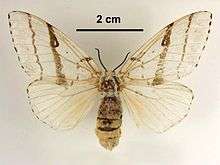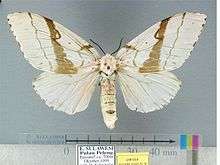Lymantria lunata
Lymantria lunata, the luna gypsy moth, is a moth of the family Erebidae. The species was first described by Caspar Stoll in 1782. It is found in Southeast Asia, from India to the northeast coast of Australia.
| Lymantria lunata | |
|---|---|
 | |
| Female | |
 | |
| Lymantria lunata curvifera | |
| Scientific classification | |
| Kingdom: | Animalia |
| Phylum: | Arthropoda |
| Class: | Insecta |
| Order: | Lepidoptera |
| Superfamily: | Noctuoidea |
| Family: | Erebidae |
| Genus: | Lymantria |
| Species: | L. lunata |
| Binomial name | |
| Lymantria lunata (Stoll, 1782) | |
| Synonyms | |
| |
The wingspan is about 60 mm. The body is brown and the wings are white with a pattern of brown lines on the forewings.
The larvae have been recorded feeding on Mangifera indica, Buchanania muelleri and Ficus benjamina.
Subspecies
- Lymantria lunata lunata
- Lymantria lunata diversa
- Lymantria lunata curvifera
gollark: Well, if you have a political compass™ result (the good 3-axis version), you can submit it for inclusion.
gollark: U+2061 is FUNCTION APPLICATION and also invisible?
gollark: U+202E is LEFT TO RIGHT OVERRIDE.
gollark: U+262D is ☭ HAMMER AND SICKLE.
gollark: Hmm, maybe hive minds are more leftist actually.
References
- Herbison-Evans, Don & Crossley, Stella (5 September 2009). "Lymantria lunata (Stoll, 1782)". Australian Caterpillars and their Butterflies and Moths. Retrieved 24 March 2020.
This article is issued from Wikipedia. The text is licensed under Creative Commons - Attribution - Sharealike. Additional terms may apply for the media files.